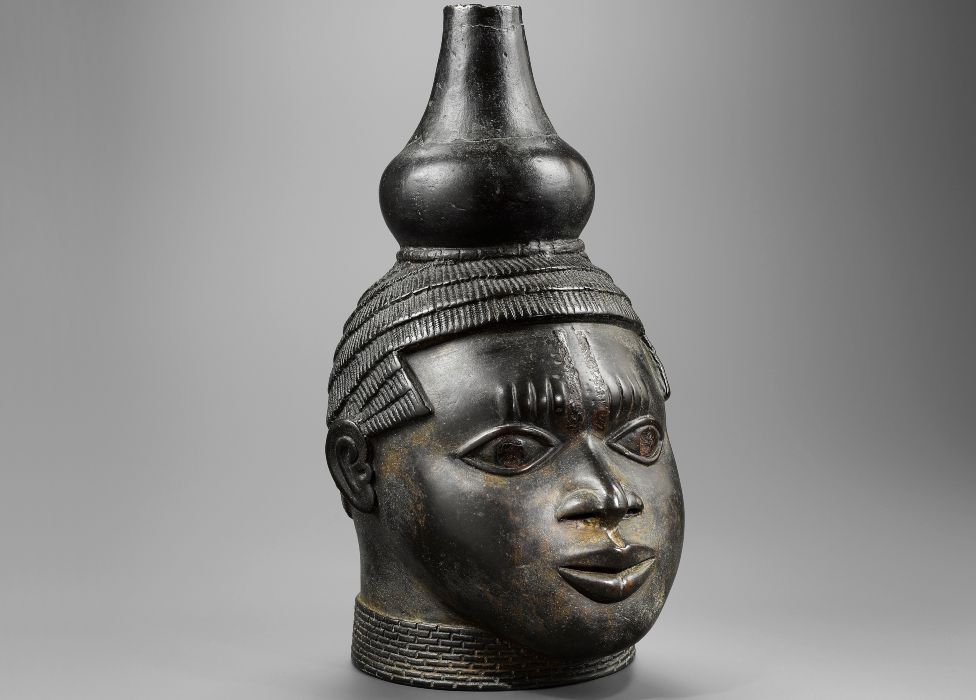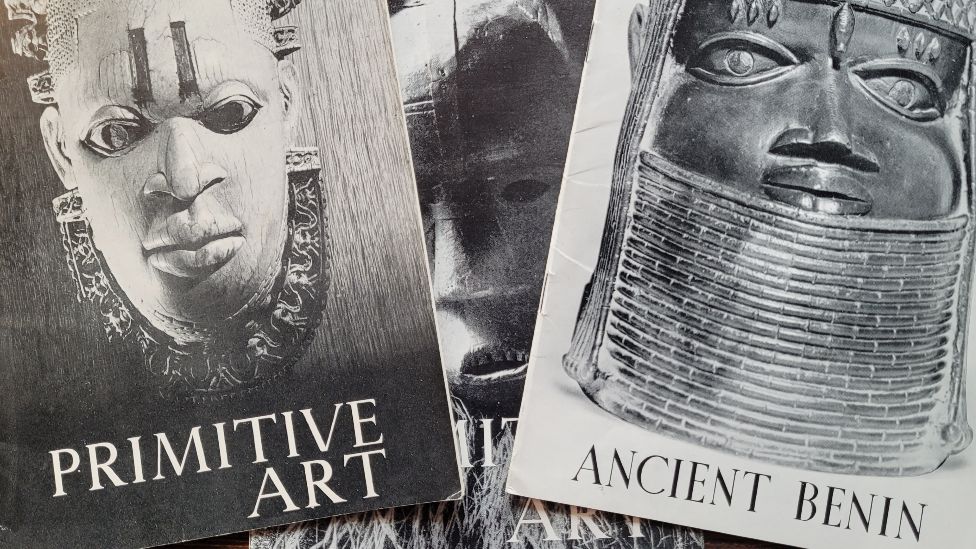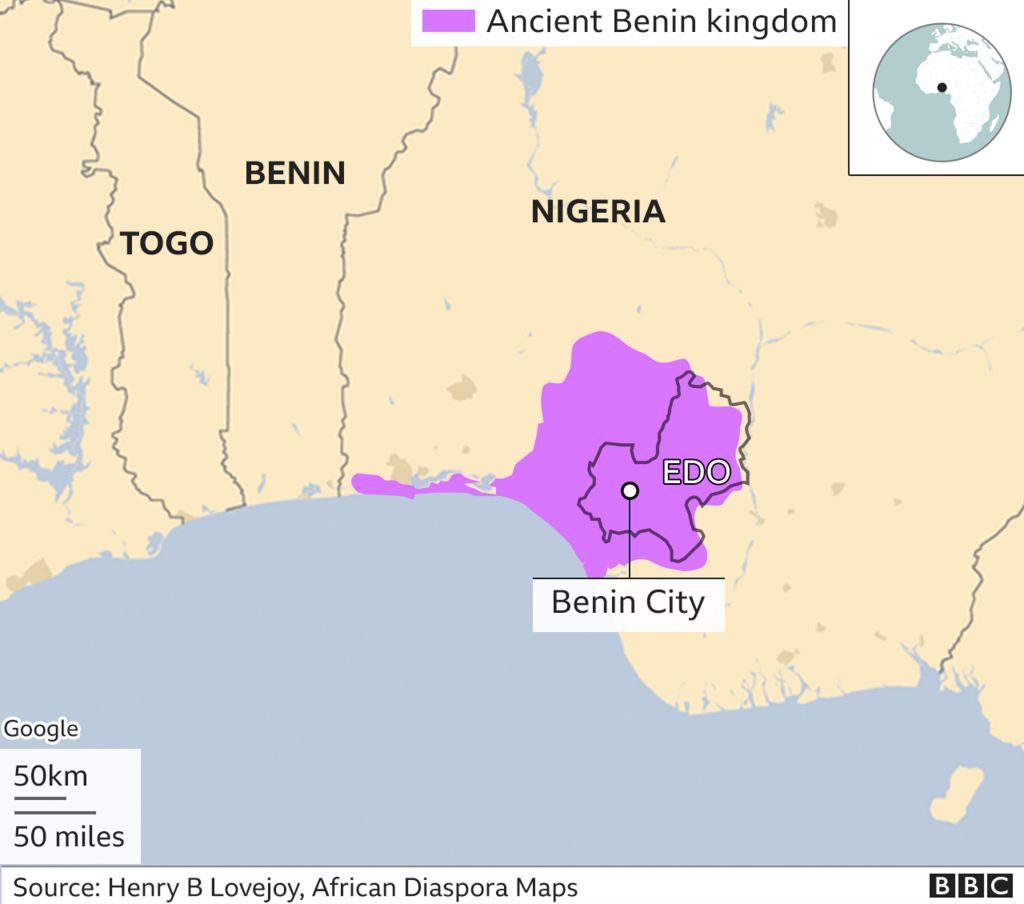The art dealer, the £10m Benin Bronze and the Holocaust
 image copyrightWoolley and Wallis
image copyrightWoolley and WallisCountless historic artefacts were looted from around the world during the colonial era and taken to Europe but there is now a growing campaign to return them. Among the most famous are the Benin Bronzes seized from modern-day Nigeria. Barnaby Phillips finds out about one family's dilemma.

One morning in April 2016, a woman walked into Barclays Bank on London's exclusive Park Lane, to retrieve a mysterious object that had been locked in the vaults for 63 years.
Attendants ushered her downstairs. Three men waited upstairs, perched anxiously on an uncomfortable sofa, watching customers go about their business.
Twenty minutes later the woman appeared, carrying something covered in an old dishcloth. She unwrapped it, and everyone gasped.
A youthful face cast in bronze or brass stared out at them. He had a beaded collar around his neck and a gourd on his head.
The men, an art dealer called Lance Entwistle and two experts from the auctioneers Woolley and Wallis, recognised it as an early Benin Bronze head, perhaps depicting an oba, or king, from the 16th Century.
It was in near-immaculate condition, with the dark grey patina of old bronze, much like a contemporary piece from the Italian Renaissance. They suspected it was worth millions of pounds. The bank staff quickly led them into a panelled room, where they placed the head on a table.
The woman who went down into the vaults is a daughter of an art dealer called Ernest Ohly, who died in 2008.
I have chosen to call her Frieda and not reveal her married name to protect her privacy.
Ernest's father, William Ohly, who was Jewish, fled Nazi Germany and was prominent in London's mid-century art scene.
 image copyrightBarnaby Phillips
image copyrightBarnaby PhillipsWilliam Ohly lived "at the nexus of culture, society and artists", says Entwistle.
His "Primitive Art" exhibitions attracted collectors, socialites, and artists such as Jacob Epstein, Lucian Freud, Henry Moore, Francis Bacon, Duncan Grant and Vanessa Bell.
He died in 1955. Ernest Ohly inherited his love of art, but was a more reserved character.
"A very, very difficult man to know. He didn't let anything out. You did not know what he was thinking," said Entwistle.
Ernest Ohly's death provoked a ripple of excitement at the lucrative top end of the ethnographic art world. He was rumoured to have an extensive collection. His statues from Polynesia and masks from West Africa were auctioned in 2011 and 2013. And that, dealers assumed, was that.
But his children knew otherwise. In old age, he had told them he had one more sculpture. It was in a Barclays safe box and not to be sold, he specified, unless there was another Holocaust.
In 2016 matters were taken out of the children's hands. Barclays on Park Lane was closing its safe boxes; it told customers to collect their belongings.

I met Lance Entwistle in 2019, in his library lined with books on African sculpture. His website said his company has been "leading tribal art dealers for over 40 years".
"Tribal art" is a term that Western museums now avoid, but is still common in the world of auctions and private sales.

Entwistle has rarely been to Africa, and never to Nigeria, but he's well connected. The British Museum, the Musée du Quai Branly in Paris and the Metropolitan in New York have all bought pieces from him.
I asked him how he had felt when Frieda pulled the cloth away from the Benin Bronze head in the bank.
"I was bowled over," he said. "It was beautiful, moving, and its emergence from obscurity was so exciting. I'm very used to being told about a Benin head, a Benin plaque, a Benin horse and rider. Generally I'm not excited because 99 times out of 100 they're fake, and often the remaining 1% has been stolen."
Provenance is everything in Entwistle's world. This time, thanks to the Ernest Ohly connection, he was confident he was dealing with a bona fide piece.
He told Frieda the Benin Bronze head was significant and unusual, and convinced her to take it home in a taxi, to her terraced house in Tooting, south London.

The Benin Bronzes were brought to Europe in the spring of 1897, the loot of British soldiers and sailors who conquered the West African kingdom of Benin, in modern day Nigeria's Edo state.
Although they are called Benin Bronzes, they are actually thousands of brass and bronze castings and ivory carvings. When some were displayed in the British Museum that autumn, they caused a sensation.

Africans, the British believed at the time, did not possess skills to produce pieces of such sophistication or beauty. Nor were they supposed to have much history.
But the bronzes - some portrayed Portuguese visitors in medieval armour - were evidently hundreds of years old.

Benin had been denigrated in British newspapers as a place of savagery, a "City of Blood". Now those newspapers described the Bronzes as "surprising", "remarkable" and admitted they were "baffled".
Some of these bronzes are still owned by descendants of those who pillaged Benin, while others have passed from owner to owner.
Victor Ehikhamenor, an artist from Edo state, told me the bronzes were not made only for aesthetic enjoyment.
"They were our documents, our archives, the 'photographs' of our kings. When they were taken our history was exhumed."
But as their value in the West has increased, they've also become prestige investments, held by the wealthy and reclusive.
London auction sales tell the story. In 1953, Sotheby's sold a Benin Bronze head for £5,500. The price raised eyebrows; the previous record for a Benin head was £780.
In 1968 Christie's sold a Benin head for £21,000. (It had been discovered months earlier by a policeman who was pottering around his neighbour's greenhouse and noticed something interesting amidst the plants).
In the 1970s, "Tribal Art" prices soared, and Benin Bronzes led the way. And so it went on, all the way to 2007 when Sotheby's in New York sold a Benin head for $4.7m (£2.35m).



No comments